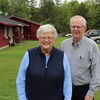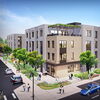
Processing Your Payment
Please do not leave this page until complete. This can take a few moments.
At the University of New England, Maine's only medical school moves ahead
 Photo / Tim Greenway
University of New England President James Herbert and Jane Carreiro, vice president for health affairs and dean of the UNE College of Osteopathic Medicine, at the construction site of the new medical building on the UNE Portland campus
Photo / Tim Greenway
University of New England President James Herbert and Jane Carreiro, vice president for health affairs and dean of the UNE College of Osteopathic Medicine, at the construction site of the new medical building on the UNE Portland campus
Construction is underway on the University of New England’s Harold and Bibby Alfond Center for Health Sciences, a pivotal step in relocating UNE’s College of Osteopathic Medicine, or COM, to Portland and establishing a comprehensive health sciences campus there.
The relocation of the medical school from its original site in Biddeford will allow the university to admit more students and bring together the health profession programs onto a single, interprofessional campus.
The campus is designed so that students in Maine’s only medical school, dental school and physician assistant program can collaborate directly with their peers in nursing, social work, pharmacy, physical therapy, occupational therapy, dental hygiene and nurse anesthesia.
“Our health professions students will benefit from amazing new learning spaces in the new facility designed for simulation, standardized patients, and digital health and telemedicine, all of which will help UNE to realize its full potential as a national leader in interprofessional health professions education,” says UNE President James Herbert.
Construction of the 110,000-square-foot building started in November 2022; completion is expected next summer. Goals include teaching best-in-class skills, improving patient outcomes through team-based care, fostering expertise with new and emerging technologies, and expanding cross-cultural competencies.
COM origin
The origins of UNE’s College of Osteopathic Medicine date to 1978, when St. Francis College, a four-year college in Biddeford, began discussions with the New England Foundation for Osteopathic Medicine. That led to the founding of the New England College of Osteopathic Medicine. St. Francis and the College of Osteopathic Medicine then combined to create the University of New England.
The medical school has grown to include its original home, Stella Maris Hall, which now houses offices and various departments. The Harold Alfond Center for Health Sciences houses laboratories and lecture halls, the Pickus Center for Biomedical Research houses research teams, the University of New England School of Pharmacy has dedicated research space, and Leonard Hall is one of the largest interactive classrooms of its kind in the country. The Clinical Performance Center is modeled as an outpatient health center and houses a patient simulator program.
But in recent years the med school outgrew its Biddeford location.
“The new building will be much larger and designed for the way medical school is taught today and how we anticipate it will be taught in the future,” says Herbert.
For example, the gross anatomy lab, currently in cramped basement quarters, will double in size on the new building’s top floor with lots of natural light. Telehealth infrastructure, currently a piecemeal affair, will be purpose-built.
The facility itself is intentionally designed to encourage relationships, both formal and informal, between the health professions.
“We don’t want to create a building that’s just for medical students and they never come out and our nursing and pharmacy and other health care students never go in,” says Herbert. “There will be a migration of students in and out of the building.”
Even smaller features — such as a walkway and café — were purposely placed to ensure mingling of COM, Westbrook College of Health Professions and College of Dental Medicine students.
Design
UNE recruited Portland-based SMRT Architects and Engineers for the design, led by Phil Chaney.
“One of the things that was important for us was to integrate the new COM building with the existing historic campus,” says SMRT President Ellen Belknap.

The new building connects to the older Innovation Hall. It’s oriented with the front door facing the historic campus.
“We’re knitting together the fabric to make one campus, instead of a historic campus with an adjunct medical school,” says Belknap.
The center is roughly shaped like a backward “L” with the foot of the “L” extended by a glass walkway connecting with Innovation Hall. The “L” wings, with large expanses of glass, border a courtyard.
The first and second floors have interactive group rooms, offices, soft seating areas, a large lecture hall, restrooms, changing rooms and a lactation room. The third and fourth floors have a large classroom, interactive group rooms, additional offices, a faculty suite, teaching and clinical skills training pods, a morgue and labs.
Features designed with ease of teaching and collaborative learning in mind include clinical skills pods — a major upgrade where students can learn procedures such as taking blood pressure and suturing. One lab pod is dedicated to non-COM health professions, reducing the need to move cadavers around.

The use of smaller pods, compared with large classrooms, allows faculty to work with specific groups of students and breaks up space, keeping down noise. Large rooms maximize collaboration. Interactive classrooms with moveable furniture allow for numerous configurations conducive to teamwork. A front-back elevator, separate from the passenger elevator, will make cadaver transport easier and more private.
Construction of smaller spaces uses a wood system called cross-laminated timber. Large spaces, like laboratories, incorporate steel framing.
“We use the steel where the demands of the program require longer spans. Wood accommodates spaces that have smaller spans,” says Belknap.
Belknap credits UNE for its sustainability mission, which sets a high bar for energy-efficiency. In the labs, the project uses German-made Konvekta high-efficiency energy recovery system — a first for SMRT. Operational savings, versus a traditional energy recovery system, is estimated at $38,000 per year. UNE also received a $47,500 rebate from Efficiency Maine that reduced the system’s payback from 7.4 to 6.1 years.
The new facility will accommodate 200 students per class, compared with 165 today. More faculty hiring is expected.
“We find there are people who have been practicing a while but they enjoy teaching,” says Herbert. “We try to find and recruit those people. We also use practicing clinicians who teach one or two days per week.”
Bedside manner
The intentions behind the interprofessional campus reflect the latest thinking in health care and how it should be taught.

“We have a problem with health care being siloed and we need to break down those silos,” says Herbert. “If you have a loved one in hospital, they treat you like you’re a bunch of disembodied body organs. You get random consults and one doctor will provide meds and then another will prescribe meds.”
Conversely, he continues, holistic, team-based approaches result in reduced medical errors, improved patient outcomes and satisfaction and reduced provider burnout.
“There’s a movement nationally to break down those silos and train students to work as part of interprofessional teams,” Herbert continues. “That’s a key piece to why we’re moving our medical school to Portland — because even though we’re living the model, we can’t fully realize it with the medical school being on one campus and the other health disciplines being on another campus.”
Maine’s major hospital systems have endorsed the project.
“There’s tons of data going back decades that interprofessional practice gives people the best outcomes in health care,” says Douglas Sawyer, MaineHealth’s chief academic officer. “Creating a professional practice requires interprofessional training.”
Interprofessional education
“Most health settings are working toward team-based practices,” says Shelley Cohen Konrad, director of UNE’s Center to Advance Interprofessional Education and Practice.
“Our intention is to prepare students not only to be fabulous practitioners in their own fields but to be really skilled team players no matter what team they’re on.”

Collaboration across professions is “a really powerful addition to their learning,” says Cohen Konrad.
“Interprofessional education” at UNE means that students have the opportunity to work with other health professions including but not exclusive to osteopathic medicine, dental medicine, physicians associates, dental hygiene, social work, nursing, and physical and occupational therapy.
UNE has been putting the concept into practice for more than a decade. But having the medical college on one campus and the rest of the health profession programs mostly located in Portland has made it difficult to bring together students from both programs.

To date, UNE’s strategies to foster intermingling between the Biddeford and Portland programs have included students traveling between the two campuses and, since 2020, using more virtual technology.
But that leaves behind day-to-day interactions that are important in the health care professions.
“Adding the new building and the medical students and faculty and staff in one physical space will allow us to not only do our formal programming together but have the opportunity have social and informal connectedness that cements a culture of collaboration,” says Cohen Konrad.
Patient benefits
Collaboration is important for student growth and development, says Jane Carreiro, dean of the College of Osteopathic Medicine and a 1988 graduate.
“When people are sharing resources, sharing libraries, sharing study spaces — that informal camaraderie develops,” says Carreiro. “It’s much easer for someone to take that sense of camaraderie and connection and transfer it into their practice as a clinician, because they’ve already had that experience as a student.”
Ultimately, it’s the patient who benefits. Typically, health professionals operate in silos, even speaking different medical languages at times, says Carreiro.
“You get into a lot of situations where there’s confusion, lack of communication, misunderstanding,” says Carreiro.
But when students of various disciplines train together, it opens the lines of communication — ultimately helping patients and their families.
“Each health care practitioner has a different piece of the system,” says Carreiro. “But we all have to talk with each other.”
Mainebiz web partners
Outstanding! A very bright future for UNE.












1 Comments